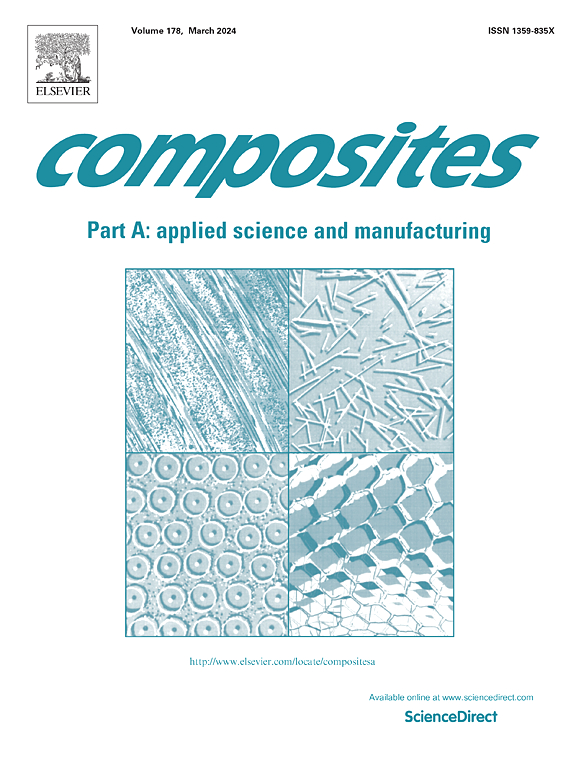可回收波透明导热复合材料的物理场原位自组装
IF 8.1
2区 材料科学
Q1 ENGINEERING, MANUFACTURING
Composites Part A: Applied Science and Manufacturing
Pub Date : 2025-07-22
DOI:10.1016/j.compositesa.2025.109202
引用次数: 0
摘要
在通信领域,高吸水性的材料具有高的微波透射率(MWT)和热导率(λ)似乎是违反直觉的。然而,利用吸水产生的流体场有望积极地将颗粒吸入材料中,从而促进功能网络的原位形成。通过耦合来自吸水的流体场和来自真空辅助过滤的吸力场,功能颗粒在苎麻管腔内进行原位自组装,形成类似于珍珠的砖瓦结构。这种微观结构使得具有吸水性能的苎麻纤维增强复合材料具有较高的MWT和λ。一方面,通过显著降低垂直于其平面的偶极矩来减弱极化率,复合材料达到了令人瞩目的98.5%的MWT。另一方面,通过增加多向声子传输系数,平面内λ和平面通λ分别达到1.2928 W/mK和2.0812 W/mK的高值。重要的是,废弃复合材料可以完全转化为功能颗粒,从而实现闭环回收。该研究为基于吸收材料的可回收波透明导热复合材料的开发提供了新的思路。本文章由计算机程序翻译,如有差异,请以英文原文为准。

In-situ self-assembly from physical fields for recyclable wave-transparent heat-conducting composites
In the field of communication, it seems counterintuitive that materials with high water absorption have high microwave transmittance (MWT) and thermal conductivity (λ). However, utilizing the fluid field generated by water absorption is expected to actively draw particles into the material, thereby facilitating the in situ formation of functional networks. Herein, coupling the fluid field from water absorption and the suction field from vacuum-assisted filtration, functional particles undergo situ self-assembly within the ramie lumen to form a nacre-like brick-and-mortar microstructure. This microstructure enables ramie fiber-reinforced composites with water-absorbing properties to have high MWT and λ. On one hand, by significantly reducing the dipole moment perpendicular to its plane to weaken polarizability, the composite achieves an impressive MWT of 98.5 %. On the other hand, by increasing multi-directional phonon transmission coefficients, both in-plane λ and through-plane λ reach high values of 1.2928 W/mK and 2.0812 W/mK, respectively. Importantly, the waste composite can be fully converted into functional particles, thereby achieving closed-loop recycling. This study provides a novel insight for developing recyclable wave-transparent heat-conducting composites based on absorbent materials.
求助全文
通过发布文献求助,成功后即可免费获取论文全文。
去求助
来源期刊

Composites Part A: Applied Science and Manufacturing
工程技术-材料科学:复合
CiteScore
15.20
自引率
5.70%
发文量
492
审稿时长
30 days
期刊介绍:
Composites Part A: Applied Science and Manufacturing is a comprehensive journal that publishes original research papers, review articles, case studies, short communications, and letters covering various aspects of composite materials science and technology. This includes fibrous and particulate reinforcements in polymeric, metallic, and ceramic matrices, as well as 'natural' composites like wood and biological materials. The journal addresses topics such as properties, design, and manufacture of reinforcing fibers and particles, novel architectures and concepts, multifunctional composites, advancements in fabrication and processing, manufacturing science, process modeling, experimental mechanics, microstructural characterization, interfaces, prediction and measurement of mechanical, physical, and chemical behavior, and performance in service. Additionally, articles on economic and commercial aspects, design, and case studies are welcomed. All submissions undergo rigorous peer review to ensure they contribute significantly and innovatively, maintaining high standards for content and presentation. The editorial team aims to expedite the review process for prompt publication.
 求助内容:
求助内容: 应助结果提醒方式:
应助结果提醒方式:


